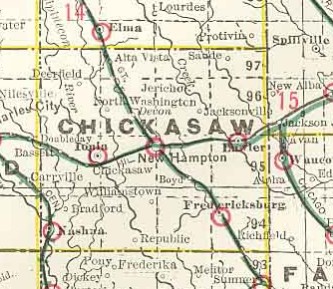The Chickasaw Flood Story
Chickasaw County, Iowa
It is unclear why Chickasaw County bears the name of one of the five tribes that, in the 1830s, President Jackson ordered removed from the southeastern United States and sent west of the Mississippi River to what is now Oklahoma. In prehistory their ancestors may have lived west of the Mississippi before migrating further east, but that wouldn’t seem to explain the naming of the county formed in 1851.
Other native people did occupy the county early settlers entered and their presence was a part of struggles and negotiations over what is now Chickasaw County. In 1840, for example, following the US government’s determination to create a “neutral ground” between the “Sac and Fox” (Sauk and Meskwaki) and the “Sioux” (Lakota and Dakota) who engaged in disputes about hunting territories, an early white migrant to Bradford township broke up 400 acres of prairie and fenced it as farm land that he anticipated the “Winnebagoes” (Ho Chunk) would work when the government moved them into the “neutral ground.” But the Ho Chunk were not interested in this arrangement or in living between the Sauk and Meskwaki and the Lakota/Dakota, so the entrepreneur returned to or remained in Illinois, the land returned to prairie, and prairie fire removed the fences. Later Bradford reemerged as the home of the Little Brown Church in the Vale, dedicated in 1864 and made famous by Dr. Pitts’s song.
Since the Chickasaw name has remained with the county, it seems fitting to offer their ancient flood story: “Long ago, perhaps in the days when our Chickasaw ancestors still resided in the land of the setting sun, the Great Spirit, Aba’Binni’li’, sent rain. Soon, water covered all the Earth. Some Chickasaws made rafts to save themselves. Then, creatures like large white beavers cut the thongs that bound the rafts. All drowned except one family and a pair of each of all the animals. When the rain stopped and the flood began receding, a raven appeared with part of an ear of corn. Aba’Binni’li’ told the Chickasaws to plant it. Aba’Binni’li’ also told them that, eventually, the Earth would be destroyed by fire, its ruin presaged by a rain of flood and oil.
Chickasaws are not the only North American Indian Tribe who has a story of the flood. Almost every other ancient people, from the Chinese to the Mayans and Incas, had their own version that told of destruction of the world by water.”

Image Source: IAgenweb.org
Sources: SHSI: W.E. Alexander, History of Chickasaw and Howard Counties, Decorah, 1883; “The Little Brown Church in Story and In Song, “ 1941; on line: www.chickasawnation.net.
